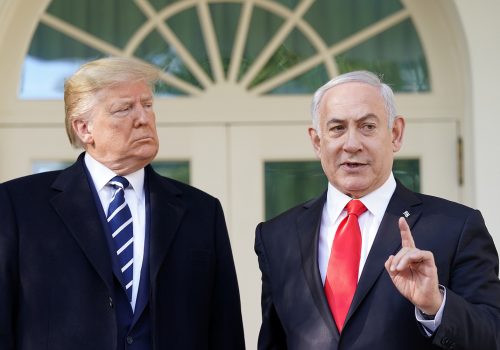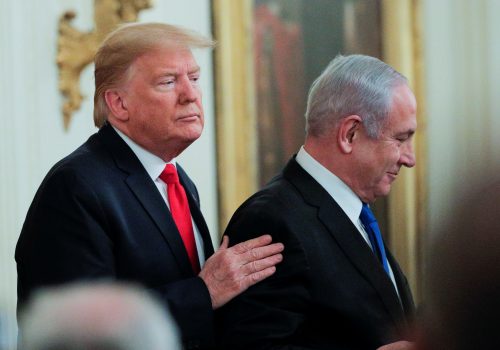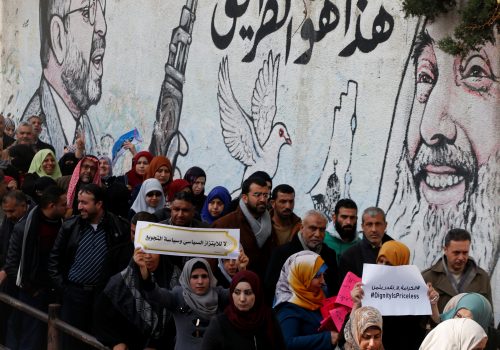Should the Palestinians look a gift horse in the mouth?
$50 billion for investment over ten years sounds very enticing. Especially as a lifeline out of the long-stagnant Israeli-Palestinian peace process. This princely sum is the economic incentive to sweeten the Trump administration’s “deal of the century.” It is certainly less contentious than its political counterpart, just unveiled on January 28. But it comes with fine print and strings attached.
Foremost is the contingency of the economic funds on a political solution. In the Trump administration’s own words, the economic plan is “ready to be implemented in the event that peace can be made on terms consistent with this Vision.” Translation: If the Palestinian authorities do not sign on to US President Donald Trump’s approach, they do not get the money.
Second, the $50 billion price tag means much less for the Palestinians themselves. They would receive less than $28 billion, with the rest divided among Jordan, Egypt, and Lebanon. However, the lesser amount allocated for the Palestinians could be a blessing in disguise.
Conceivably, Palestinian policymakers might not actually want all that cash. This is in part because of the challenges associated with spending such a vast sum. An economy of only $15 billion in GDP might not have enough worthy projects on which to spend that kind of money. In that case, foisting this largesse on the fledgling nation-state could distort the local economy, crowd out local funds, and fuel mismanagement.
Perhaps more importantly for the Palestinian National Authority, this money is not free. Partly, the cost comes in terms of political concessions to Israel on settlements, Jerusalem, security and so on. However, there is also a direct financial cost.
Of the proposed $50 billion, only $13 billion comes in the form of grants, across all four country recipients. $25 billion is allocated to “subsidized loans,” with multilateral development banks, the United States, and wealthy Gulf countries rumored to be potential major contributors. The key question here becomes: subsidized how much?
For an economy this small, it makes a big difference whether the Palestinians are paying 1 percent or 7 percent in interest on loans of this size. The World Bank’s middle-income lending organization, the International Bank for Reconstruction and Development (IBRD), offers some regional clues already. Average interest rates for similar sized countries such as Jordan, Tunisia and Lebanon range from 2 – 4 percent.
On a loan value of $25 billion, this translates to $500 million to $1 billion per year in interest in addition to repayment of the loan itself—an enormous sum for the Palestinians. This does not all come at once, since the investments are phased over ten years, but begins to give a sense of the weight of debt. Multilateral institutions also have many shareholders to satisfy and could be wary of putting so much capital at risk in a newly stabilized region.
The last tranche of investment—$12 billion from private investors—is perhaps the most problematic. They will be hard to strongarm into offering favorable rates or into funding projects at all unless there is a compelling return on investment. The Palestinian economy has great untapped potential, but also considerable geopolitical risk that many investors will wish to steer clear of.
Neighboring and heavily indebted Lebanon, itself going through a period of prolonged instability, is so shunned by foreign markets that it could have to pay as much as 15 percent for future debt. Elsewhere in the region, even the government of relatively stable and wealthier Tunisia is finding itself with no choice but to offer interest rates of 6 – 7 percent on its government bonds. To the extent that funds will go directly to specific projects, backers would be likely to ask for even steeper compensation to offset increased risk.
Deployed effectively, loans can accelerate economic growth. Unfortunately, they can also fuel a cycle of indebtedness where more debt must be raised to pay back existing loans. Tunisia is familiar with this dynamic, too, with 22 percent of their 2020 government budget allocated to debt payments.
Altogether, likely interest rates mean the nascent nation-state of Palestine could be paying total interest in the order of $750 million on private debt and $750 million on multilateral debt. That equates to 10 percent of current GDP and would add to an existing finance gap of $600 million. It is also similar to the proportion of GDP that Lebanon’s government is paying in interest, as markets speculation grows about when rather than if Lebanon will default. In other words, for up to a decade after any finalized peace plan, Palestine’s financial sustainability would be precarious.
With the specter of indebtedness looming over the economic part of the peace plan, Palestinian policymakers would be forgiven for being leery of this munificence. After all, there is no such thing as a free lunch.
Kyle Thetford is an intern with the Middle East Programs. Previously, he worked at the US Treasury Department where he was part of the team that designed the economic framework for the White House peace plan.
Image: Palestinian demonstrators during a protest against the US President Donald Trump's Middle East peace plan, in the southern Gaza Strip January 29, 2020 (Reuters)



